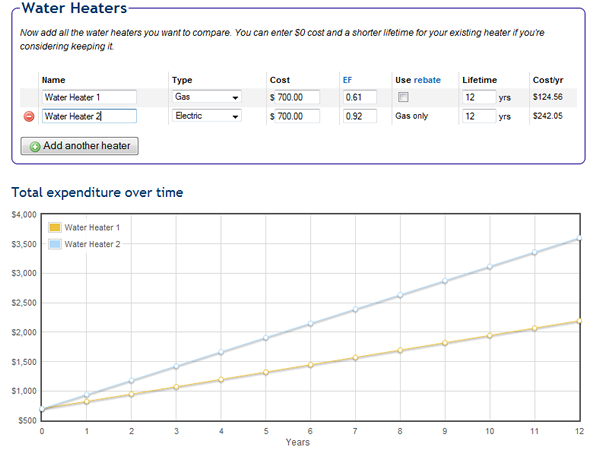Water Heater Cost / Payback Calculator
For the last few months my partner and I have been trying to decide on a new water heater. After moving into our new place, we realized that the existing electric tank water heater wasn’t working right since the temperature of our showers steadily got colder. It was suggested that one of the heating elements was busted, but I wasn’t interested in getting it repaired since the heater was way older than the expected lifetime of an electric heater. However, there are a lot of choices for a replacement. Another electric tank water heater would be cheap, a gas tank heater would be cheaper to run but require running a gas line, and there are tankless water heaters which are much more expensive but are cheaper to operate and don’t have to keep a whole tank of water heated up all the time for the few times you use it.
There are a number of ways out there for you to figure out how the cost of installation and purchase balance out with the cost of operation over time. You can always make your own Excel spreadsheet to figure it out, or you can use calculators like this one from energy.gov. However, all the web payback calculators I’ve seen have had clunky 90s interfaces, don’t take into account all the variables, and most importantly, don’t let you compare multiple types of heaters at the same time. So, like any good software developer, I built my own.
My water heater calculator is based on the same calculations used on the Federal Energy Management Program site, with the addition of inputs for your hot and cold water temperature. It’s also more flexible about how you enter your water usage. But the best part is that you can enter as many different water heaters as you want and they’ll all be graphed against each other, taking into account the lifetime of the unit. Get multiple bids, try different models, compare gas and electric. By displaying them as a graph of total cost over time, you can see where each heater breaks even with each other, and how much savings you’re getting by the end.
As a bonus, the calculator will also calculate how much you may be able to claim as part of the Energy Star Federal Tax Credit program. It’s smart enough to know the rules about the credits (gas heaters >e; 0.82 efficiency only, 30% of total cost up to $1500), and you can choose not to use the rebate if you’ve already used it up this year or don’t plan on applying it to your heater.
You can get started with the calculator by filling in values for your water usage and resource costs, or accept the defaults. Then add as many heaters as you like, entering in the cost for purchase and installation, the Energy Factor (which should be in the documentation for the heater), and the estimated lifetime of the heater. The more accurate you can make the numbers, the better your cost projection will be. Then check out the graph to see what your total expenditure will be after every year. If you’re comparing a new heater with the option of keeping your existing heater, just set the Cost to $0 and reduce the lifetime to how long you expect your existing heater to last.
Hopefully this little tool will be helpful to anyone else looking to replace their water heater. I filled it out for a combination of several electric, gas tanked, gas tankless, and heat-pump based water heaters, and it gave me a much better picture of what was worth it and what wasn’t. In the end, even though the graphs told me that the increased efficiency of a gas tankless heater wouldn’t ever pay back the cost difference versus an electric tank water heater, we ended up going with one. The promise of infinite hot water (long showers after a hike!) and no chance of burst water heaters outweighed the additional cost. But at least we were well-informed!
